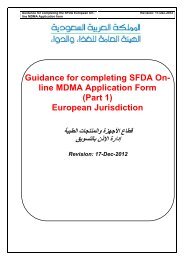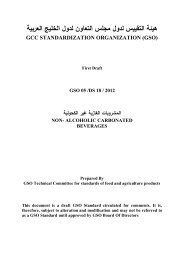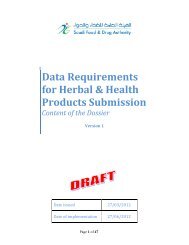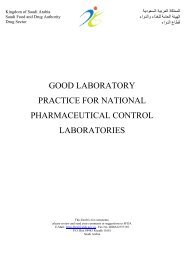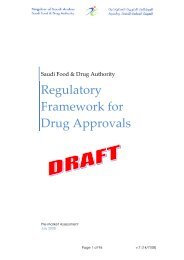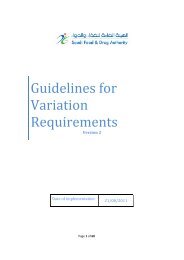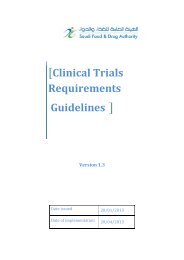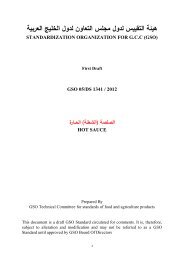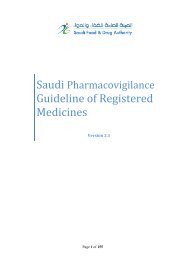Saudi Drug Code (SDC), and Drug Barcoding Specifications
Saudi Drug Code (SDC), and Drug Barcoding Specifications
Saudi Drug Code (SDC), and Drug Barcoding Specifications
Create successful ePaper yourself
Turn your PDF publications into a flip-book with our unique Google optimized e-Paper software.
<strong>Drug</strong> SectorLicensing Executive DirectorateGuidance for Industry<strong>Saudi</strong> <strong>Drug</strong> <strong>Code</strong> (<strong>SDC</strong>), <strong>and</strong><strong>Drug</strong> <strong>Barcoding</strong> <strong>Specifications</strong>This document outlines the new proposed barcode requirements for pharmaceuticals. Is is a draftcopy for comments.Version 0.2Please send your comments to sdr.drug@sfda.gov.sa
Document ControlVersion Date Author Comments0.1 12/12/12Business Support <strong>and</strong> Archiving Unit.Licensing Executive Directorate0.2 07/01/13 Business Support <strong>and</strong> Archiving Unit.Licensing Executive DirectorateFirst DraftPublished for comments2 | P a g e
Table of ContentsI. Introduction ........................................................................................................................ 4II. Objectives ........................................................................................................................... 4III. Requirements .................................................................................................................. 41. Carrier ............................................................................................................................. 42. Data................................................................................................................................. 53. Print ................................................................................................................................ 54. Serial Number .................................................................................................................. 55. GLN: ................................................................................................................................ 6IV. <strong>Saudi</strong> <strong>Drug</strong> <strong>Code</strong> .............................................................................................................. 6V. Databases: ........................................................................................................................... 7VI. What Industry has to do? ................................................................................................. 7VII. Benefits ........................................................................................................................... 8a) To the Industry ................................................................................................................ 8b) To distributors <strong>and</strong> wholesalers: ...................................................................................... 8c) To retail pharmacies ........................................................................................................ 9d) To Hospitals: .................................................................................................................... 9VIII. Appendix A: GS1 Data Matrix (2D) Barcode .................................................................... 10a) Definition ...................................................................................................................... 10b) Printing Location............................................................................................................ 10c) Printing Instructions ...................................................................................................... 10d) Readers ......................................................................................................................... 10IX. Appendix B: Global Trade Item Number (GTIN) .............................................................. 11a) Definition ...................................................................................................................... 11b) GTIN-14 ......................................................................................................................... 11c) Why GTIN ...................................................................................................................... 11X. Appendix C: Global Location Number (GLN)....................................................................... 12a) Definition ...................................................................................................................... 12b) Why GLN?...................................................................................................................... 123 | P a g e
XI. References..................................................................................................................... 13I. IntroductionUnified st<strong>and</strong>ards for automatic identification in the healthcarefield provide an opportunity to make the drug supply chain in <strong>Saudi</strong>Arabia, safer <strong>and</strong> yet more efficient <strong>and</strong> accurate. The <strong>Drug</strong> Sector in<strong>Saudi</strong> Food <strong>and</strong> <strong>Drug</strong> Authority (SFDA) believes that a st<strong>and</strong>ardizedidentification system from the manufacture to the patient is imperativeto comply with the increasing need for product integrity <strong>and</strong> traceability.Therefore, <strong>and</strong> since the Global St<strong>and</strong>ards (GS1) system, globallyendorsed by the healthcare community, is one of the most widely usedtrade item identification systems worldwide (GS1, 2011), the <strong>Drug</strong>Sector is urging all drug manufacturers in <strong>Saudi</strong> Arabia <strong>and</strong> internationalmanufacturers exporting to <strong>Saudi</strong> Arabia, to adopt GS1 supply-chainst<strong>and</strong>ards. This document outlines the new requirements, benefits, <strong>and</strong>the current <strong>and</strong> future objectives of this projects.II.Objectives Increase patient safety <strong>and</strong> reduce medication errors. Traceability <strong>and</strong> fast product recalls or withdrawals. Counterfeit detection. Real-time <strong>and</strong> accurate information flow between stakeholders.III.Requirements1. CarrierAll drugs’ marking must be upgraded from linear barcodes (Figure A)to GS1 Data Matrix Barcode (Figure B).4 | P a g e
(Figure A) Linear Barcode(Figure B) GS1 Data Matrix2. DataThe Data Matrix barcode shall carry the following data:3. Print GTIN-14 : GS1 Global Trade Identification Number (productidentification code). Expiry Date in DDMMYY format (Attribute). Batch/Lot Number (Attribute).The following data must be printed on the drug secondary package justbeside or below the Data Matrix barcode:4. Serial NumberGTIN: 00000000000011EXPIRY: YYYY-MM-DDBATCH/LOT: ABCD1234Marking each drug package with a unique serial number will berequired by SFDA in the future in order to support the drug track <strong>and</strong>trace process. This number will be required to be printed along with theother attributes <strong>and</strong> encoded within the Data Matrix barcode. There willbe further support documentation published by SFDA to illustrate itsspecifications.5 | P a g e
IV.5. GLN:All pharmaceutical manufacturers must acquire a Global LocationNumber (GLN) from GS1 for their manufacturing sites. This number willbe required by SFDA’s drug systems in order to uniquely identify everyphysical location.<strong>Saudi</strong> <strong>Drug</strong> <strong>Code</strong><strong>Saudi</strong> <strong>Drug</strong> <strong>Code</strong> (<strong>SDC</strong>) is a new registration code that is going tobe given by the <strong>Drug</strong> Sector to each registered drug in the <strong>Saudi</strong> market.This new code shall eventually replace the current drug registrationnumber (example: A) which is normally granted with the approval of thedrug registration.Example: a12-111-07The <strong>SDC</strong> will contain fewer variables than its predecessor. Therefore, itwill be more stable <strong>and</strong> reflecting the application type in addition to theyear of registration. The following illustrate the structure of <strong>SDC</strong>:<strong>Drug</strong> –Health or Herbal- Vet - ListedFixed PrefixSFDA 99 D 122SFDA 12 H 064SFDA 03 V 012SFDA 12 L 001Serial NumberYear6 | P a g e
Here are some examples of the final SNDC format:V. Databases:SFDA12D001SFDA13H011SFDA14V111The <strong>Drug</strong> Sector will start gradually to collect all registered drug’s GTIN-13 numbers in order to add them to the database that is currently beingpublished periodically on the SFDA’s website. Each registered item in thedatabase is going to carry a GTIN-13 <strong>and</strong> a <strong>SDC</strong> as in the followingexample:VI.What Industry has to do?1. Contact the GS1 office for more information about acquiring GTIN,GLN, <strong>and</strong> Data Matrix barcodes.2. Prepare the production lines for printing <strong>and</strong> verifying the newbarcodes.3. Plan to be logistically ready for serializing all products in the future.NoteAll stakeholders’ supply chain databases have to be constructed in away that they accept 14-digit Global Trade Item Numbers. However,SFDA database will provide GTIN-13 numbers for each item (lackingthe front digit that is assigned for the packaging level).7 | P a g e
VII.Benefitsa) To Manufacturers Reduce inventory assets: Improve dem<strong>and</strong> forecasting<strong>and</strong> inventory planning. Reduce inventory financing <strong>and</strong> holding cost:o Reduce financing due to lower inventory assets.o Reduce inventory management cost with more efficient <strong>and</strong>accurate processes. Reduce produce waste due to obsolescence: Improve inventorymanagement to shrink inventory levels <strong>and</strong> unused product. Reduce cost of recalls:o More efficient execution (increased supply chain visibility).o Reduce scope of recalls (better targeting). Reduction in counterfits <strong>and</strong> recovery lost profit: Reduction incounterfit supply raises sales volume. Br<strong>and</strong> Protection. To support track <strong>and</strong> trace of products. Errors reduction. To support patient <strong>and</strong> product safety. To obtain hospitals accreditation.b) To distributors <strong>and</strong> wholesalers Reduce inventory assets: Improve dem<strong>and</strong> forecasting <strong>and</strong> inventoryplanning. Reduce inventory financing <strong>and</strong> holding cost:o Reduce working capital requirements by lowering inventoryassets.o Reduce inventory management cost with more efficient <strong>and</strong>accurate processes. Recall effectiveness: distributors capture shipment lot numbers forpotential recall processing8 | P a g e
VIII.Appendix A: GS1 Data Matrix (2D) Barcodea) DefinitionIt is a graphic representation of any digital data in a 2-dimensional format,with high decoding information capacity that can be read by opticalequipment. It provides: High storage capacity: Encoding <strong>and</strong> marking of a greater amount ofdata within a smaller space. Direct marking: On items where labels may not be practical. Image Readable. Auto-correction: Error detection <strong>and</strong> correction capabilities to improvethe readability of bar codes despite irregular packaging or physicaldamage to a label.b) Printing LocationThe Data Matrix barcode must be printed on one of the sides of the secondarypackaging. It must be placed preferably on a flat surface. To facilitate thereading process, it must be placed on the same side where possible.c) Printing Instructions› Ensure that the surface to be marked is suitable for printing.› Verify through testing that rubbing does not damage the marking,› Testing the legibility of barcode marking in certain moist conditions.› Using the same printing quality for information redundancy.d) ReadersTo read the Data Matrix barcode, camera-based bar code scanners arerequired. Laser bar code scanners cannot read data matrix bar codes.However, camera-based bar code scanners can read both linear <strong>and</strong> all 2-Dbar codes such as Data Matrix. Generally, camera-based scanners have ahigher price point than laser scanners, but they offer distinct advantages, suchas:10 | P a g e
› Flexibility: they can read both 2D <strong>and</strong> linear bar codes versus laserscanners which can only read linear bar codes.› Reliability: It has less moving parts than laser based scanners. Therefore,lower total cost of ownership.› It support image capture: allowing imaging of a product or anidentification card, or even a document up to 21.6 x 28 cm (8”x11”).› Compact: allow easier integration with other systems (e.g. packaging lineverification) or in a h<strong>and</strong>held computer.IX.Appendix B: Global Trade Item Number (GTIN)a) DefinitionThe GS1 Global Trade Item Number (GTIN) is an identification key thatuniquely identifies products worldwide. It can be encoded into various typesof data carriers such as Data Matrix.b) GTIN-14GTIN’s are available in several lengths. GTIN-14 is the required form <strong>and</strong> it iscomposed of 14 digits:› One digit representing the Indicator digit to indicate packaging level.› Twelve digits the GS1 Company Prefix <strong>and</strong> the Item Reference assigned byyour company.› One digit representing the Check Digit.c) Why GTIN It facilitates the global flow of trade products <strong>and</strong> associated informationused in electronic commerce. Uniquely identifies trade products at all levels of packaging (item, case, <strong>and</strong>pallet). Allows accurate machine reading of trade products when placed in barcodes. Delivers trade products data in a consistent format <strong>and</strong> structure. Simplifies supply chain management.11 | P a g e
X. Appendix C: Global Location Number (GLN)a) DefinitionThe Global Location Number (GLN) is a globally unique GS1 IdentificationNumber that is used to identify any location in the supply chain that needs tobe uniquely identified.b) Why GLN?GLN is very important to help in the location identification process. Itlinks to the organization’s name, address, <strong>and</strong> type in the databases, reducingeffort to maintain <strong>and</strong> communicate this information between all parties. Thisincreases the efficiency, accuracy <strong>and</strong> precision of sharing locationinformation, crucial to logistical operations. It is also substantial to achievetraceability in healthcare <strong>and</strong> improve supply chain efficiency <strong>and</strong> visibility.12 | P a g e
XI.References• McKinsey report: "Strength in unity: The promise of global st<strong>and</strong>ards inhealthcare"http://www.gs1.org/docs/healthcare/McKinsey_Healthcare_Report_Strength_in_Unity.pdf• 10 Steps to Bar<strong>Code</strong>s Implementationhttp://www.gs1.org/barcodes/implementation• GLN Allocation Ruleshttp://www.gs1.org/1/glnrules/• GS1 DataMatrix :An introduction <strong>and</strong> technical overview of the mostadvanced GS1 Application Identifiers compliant symbology.http://www.gs1.org/docs/barcodes/GS1_DataMatrix_Introduction_<strong>and</strong>_technical_overview.pdf• GLN in Healthcare-Implementation Guidehttp://www.gs1.org/docs/gsmp/healthcare/GLN_Healthcare_Imp_Guide.pdf• GS1 <strong>Saudi</strong> Arabiahttp://www.gs1.org/countries/saudi%20arabia• GS1 Healthcare Position Statement on GS1 DataMatrix Implementationhttp://www.gs1.org/docs/healthcare/GS1_Data_Matrix_Position_Paper.pdf13 | P a g e



